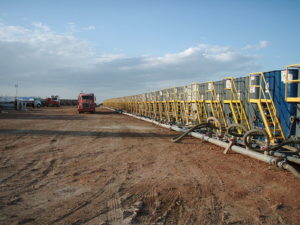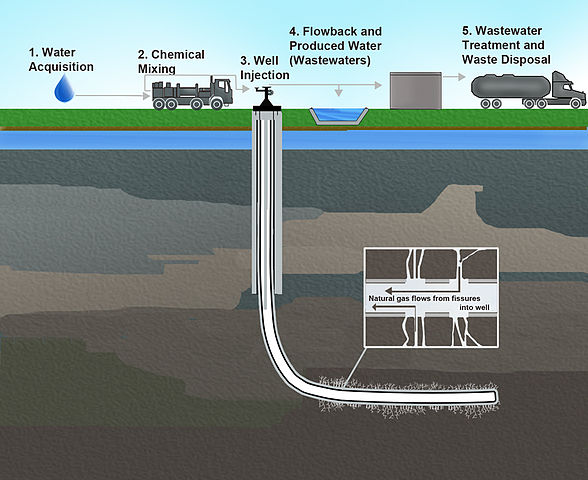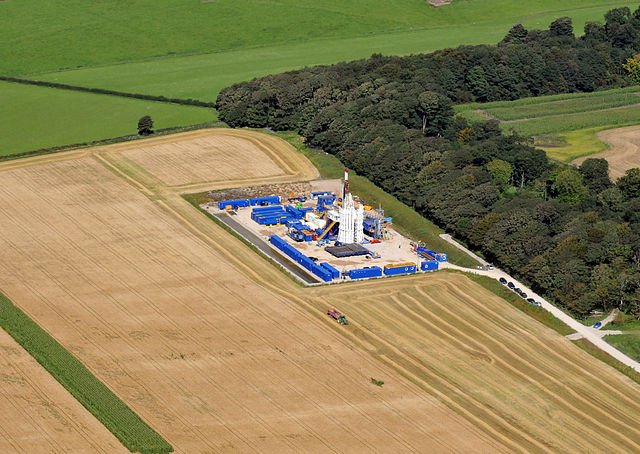
Water tanks preparing for a frac job, courtesy of Wikimedia Commons user Joshua Doubek, CC BY-SA 3.0.
On June 4, the U.S. Environmental Protection Agency (EPA) released a 998-page draft report on the effects of hydraulic fracturing on the drinking water resources of the United States. Analysts and industry professionals dove into the report as soon as it was released, knowing that the report could have far-reaching significance not only on the future regulatory conditions for fracking, but also on how the technique would be viewed by the public. It will come as no surprise, then, that advocates on both sides of the debate found parts of the report to back up their arguments either for or against continued fracking.
The report’s 28-page executive summary made headlines in pro-fracking circles with the conclusion that no evidence was found of widespread, systemic impacts on drinking water resources. The number of drinking water resources affected in the data considered was quite small compared to the total number of hydraulically fractured wells.
The report was heralded by the Wall Street Journal as showing that “fracking is safe, which won’t surprise anyone familiar with the reality of unconventional oil and natural gas drilling in the U.S.” The op-ed that ran on June 4 also took a swipe at Governor Andrew Cuomo’s New York State fracking moratorium as unnecessary. “When even the EPA blesses fracking, the self-serving political hackery behind Mr. Cuomo’s ban is exposed for all the world to see,” stated the Wall Street Journal in the final sentence of the op-ed.
However, fracking opponents also saw vindication in the EPA’s report since the conclusions mentioned specific instances of impacts on drinking water resources, including fracking fluids or produced water reaching surface or ground water and occasionally contaminating drinking water wells.
Regarding some of the polarized responses that had appeared in the media, EPA’s science advisor and deputy administrator Thomas A. Burke said in an interview on June 5, “That is not the message of this report. The message of this report is that we have identified vulnerabilities in the water system that are really important to know about and address to keep risks as low as possible.”
The EPA press release announcing the draft report listed the following vulnerabilities associated with fracking:
- Water consumption in dry areas or during droughts
- Fracking directly into formations containing drinking water resources
- Inadequately cased or cemented wells resulting in migration of gases and liquids
- Discharge of inadequately treated wastewater into drinking water resources
- Spills of fracking fluids and wastewater, including flowback and produced water
The EPA report also discussed reasons why the number of affected water resources was low in relation to the number of fracking wells. The report noted that this problematic proportion could be low either because of the actual rarity of adverse effects on drinking water resources or because of underestimates due to data limitations. Some of the limiting factors included insufficient water quality data before, during, and after fracking activities; a lack of long-term, systematic studies; insufficient information about the location of drinking water resources, particularly private drinking water wells; incomplete data on the use of chemicals associated with fracking; and lack of information about changes in industry practices.
Three U.S. Representatives, all Democrats, released a statement following the report’s release, saying, “When it comes to the water we drink, every instance of contamination must be considered serious. It is also important to note that this study relied on voluntary reporting, which affects both the quality and scope of the data available. This is an unfortunate consequence of the lack of federal regulation of hydraulic fracturing.”
It should also be noted that, while the EPA report drew on peer-reviewed studies as well as state and federal databases, the sources did not include many baseline studies examining water sources before and after fracking began in an area. EPA had planned to include such research.
Fracking has helped bring a new oil and natural gas boom to the country, but it also has caused issues when not conducted properly with sufficient care, including water rights conflicts and contamination incidents, and recently studies have connected fracking activities to earthquakes.
While it looks like we are still a long way from reaching a consensus on fracking, one thing is certain: fracking will continue to be a point of contention politically as well as environmentally for years to come. However, more studies could help clarify the debate.







Recent Comments